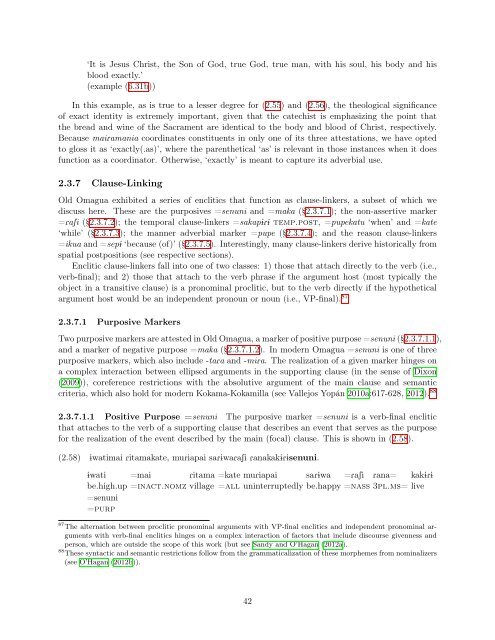draft manuscript - Linguistics - University of California, Berkeley
draft manuscript - Linguistics - University of California, Berkeley
draft manuscript - Linguistics - University of California, Berkeley
Create successful ePaper yourself
Turn your PDF publications into a flip-book with our unique Google optimized e-Paper software.
‘It is Jesus Christ, the Son <strong>of</strong> God, true God, true man, with his soul, his body and his<br />
blood exactly.’<br />
(example (6.31b))<br />
In this example, as is true to a lesser degree for (2.55) and (2.56), the theological significance<br />
<strong>of</strong> exact identity is extremely important, given that the catechist is emphasizing the point that<br />
the bread and wine <strong>of</strong> the Sacrament are identical to the body and blood <strong>of</strong> Christ, respectively.<br />
Because maiRamania coordinates constituents in only one <strong>of</strong> its three attestations, we have opted<br />
to gloss it as ‘exactly(.as)’, where the parenthetical ‘as’ is relevant in those instances when it does<br />
function as a coordinator. Otherwise, ‘exactly’ is meant to capture its adverbial use.<br />
2.3.7 Clause-Linking<br />
Old Omagua exhibited a series <strong>of</strong> enclitics that function as clause-linkers, a subset <strong>of</strong> which we<br />
discuss here. These are the purposives =senuni and =maka (§2.3.7.1); the non-assertive marker<br />
=RaSi (§2.3.7.2); the temporal clause-linkers =sakap1R1 temp.post, =pupekatu ‘when’ and =kate<br />
‘while’ (§2.3.7.3); the manner adverbial marker =pupe (§2.3.7.4); and the reason clause-linkers<br />
=ikua and =sep1 ‘because (<strong>of</strong>)’ (§2.3.7.5). Interestingly, many clause-linkers derive historically from<br />
spatial postpositions (see respective sections).<br />
Enclitic clause-linkers fall into one <strong>of</strong> two classes: 1) those that attach directly to the verb (i.e.,<br />
verb-final); and 2) those that attach to the verb phrase if the argument host (most typically the<br />
object in a transitive clause) is a pronominal proclitic, but to the verb directly if the hypothetical<br />
argument host would be an independent pronoun or noun (i.e., VP-final). 87<br />
2.3.7.1 Purposive Markers<br />
Two purposive markers are attested in Old Omagua, a marker <strong>of</strong> positive purpose =senuni (§2.3.7.1.1),<br />
and a marker <strong>of</strong> negative purpose =maka (§2.3.7.1.2). In modern Omagua =senuni is one <strong>of</strong> three<br />
purposive markers, which also include -taRa and -miRa. The realization <strong>of</strong> a given marker hinges on<br />
a complex interaction between ellipsed arguments in the supporting clause (in the sense <strong>of</strong> Dixon<br />
(2009)), coreference restrictions with the absolutive argument <strong>of</strong> the main clause and semantic<br />
criteria, which also hold for modern Kokama-Kokamilla (see Vallejos Yopán 2010a:617-628, 2012). 88<br />
2.3.7.1.1 Positive Purpose =senuni The purposive marker =senuni is a verb-final enclitic<br />
that attaches to the verb <strong>of</strong> a supporting clause that describes an event that serves as the purpose<br />
for the realization <strong>of</strong> the event described by the main (focal) clause. This is shown in (2.58).<br />
(2.58) 1watimai Ritamakate, muRiapai saR1waRaSi Ranakak1R1senuni.<br />
1wati =mai Ritama =kate muRiapai saR1wa =RaSi Rana= kak1R1<br />
be.high.up =inact.nomz village =all uninterruptedly be.happy =nass 3pl.ms= live<br />
=senuni<br />
=purp<br />
87 The alternation between proclitic pronominal arguments with VP-final enclitics and independent pronominal arguments<br />
with verb-final enclitics hinges on a complex interaction <strong>of</strong> factors that include discourse givenness and<br />
person, which are outside the scope <strong>of</strong> this work (but see Sandy and O’Hagan (2012a).<br />
88 These syntactic and semantic restrictions follow from the grammaticalization <strong>of</strong> these morphemes from nominalizers<br />
(see O’Hagan (2012b)).<br />
42
















